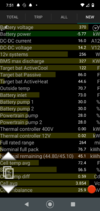NHTSA has finally made their determination on the defect petition that was submitted related to this and battery fires:
It was denied, no formal investigation will take place.
One interesting thing is that they say that there were 2,062 vehicles that had the battery voltage limited. More than were stated in @DJRas's law suit.
On October 1, 2019, the Office of Defects Investigation (ODI) opened DP19-005 to evaluate the petitioner’s request. Information provided by Tesla in response to ODI's information request letter for DP19-005 indicated that a firmware update that may limit maximum voltage was installed in certain MY 2012 through 2016 Model S vehicles (subject vehicles). The voltage limiting firmware is a dynamic algorithm that is enabled in vehicles with high Supercharging use histories, which contributes to high usage stress to the high-voltage (HV) battery. Tesla sold approximately 61,781 subject vehicles in the United States and, through August 2021, the voltage limiting firmware had been enabled in approximately 2,062 vehicles. Through December 2020, ODI identified 59 complaints from consumers alleging reductions in battery capacity (52) or charging speed (7) in the subject vehicles. Log data from these vehicles showed that the voltage limiting firmware had been enabled in about 58 percent (30 of 52) of the complaints alleging range loss. Subsequent updates have restored some or all of the battery capacity to vehicles affected by the voltage limiting firmware coupled with updates enhancing BMS battery brick monitoring algorithms. None of the complaint vehicles have reported any thermal incidents or other safety hazards related to the HV battery.
NHTSA is authorized to issue an order requiring notification and remedy of a defect if the Agency’s investigation shows a defect in the design, construction, or performance of a motor vehicle that presents an unreasonable risk to safety. 49 U.S.C. §§ 30102(a)(9), 30118. Given the absence of any incidents in the United States related to fast charging, and the absence of any such incidents globally since May 2019, it is unlikely that an order concerning the notification and remedy of a safety-related defect would be issued due to any investigation opened as a result of granting this petition. Therefore, upon full consideration of the information presented in the petition, and the potential risks to safety, the petition is denied. The denial of this petition does not foreclose the Agency from taking further action if warranted, or the potential for a future finding that a safety-related defect exists based upon additional information the Agency may receive.See Docket No. NHTSA-2020-0104
It was denied, no formal investigation will take place.
One interesting thing is that they say that there were 2,062 vehicles that had the battery voltage limited. More than were stated in @DJRas's law suit.



